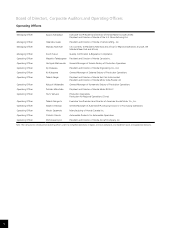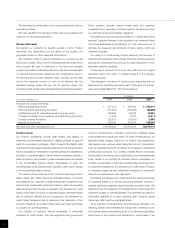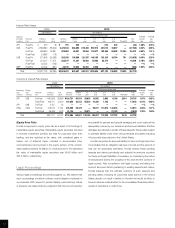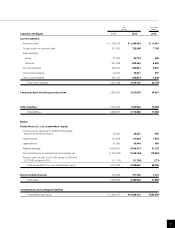Honda 2010 Annual Report Download - page 48
Download and view the complete annual report
Please find page 48 of the 2010 Honda annual report below. You can navigate through the pages in the report by either clicking on the pages listed below, or by using the keyword search tool below to find specific information within the annual report.
The following is not intended to be a comprehensive list of all our
accounting policies.
We have identified the following critical accounting policies with
respect to our financial presentation.
(Product Warranty)
We warrant our products for specific periods of time. Product
warranties vary depending upon the nature of the product, the
geographic location of their sales and other factors.
We recognize costs for general warranties on products we sell
and product recalls. We provide for estimated warranty costs at the
time products are sold to customers or the time new warranty
programs are initiated. Estimated warranty costs are provided based
on historical warranty claim experience with consideration given to
the expected level of future warranty costs, including current sales
trends, the expected number of units to be affected and the
estimated average repair cost per unit for warranty claims. Our
products contain certain parts manufactured by third-party suppliers.
Since suppliers typically warrant these parts, the expected
receivables from warranties of these suppliers are deducted from
our estimates of accrued warranty obligations.
We believe our accrued warranty liability is a “critical accounting
estimate” because changes in the calculation can materially affect
net income attributable to Honda Motor Co., Ltd., and require us to
estimate the frequency and amounts of future claims, which are
inherently uncertain.
Our policy is to continuously monitor warranty cost accruals to
determine the adequacy of the accrual. Therefore, warranty expense
accruals are maintained at an amount we deem adequate to cover
estimated warranty expenses.
Actual claims incurred in the future may differ from the original
estimates, which may result in material revisions to the warranty
expense accruals.
The changes in provisions for those product warranties and net
sales and other operating revenue for each of the years in the three-
year period ended March 31, 2010 are as follows:
(Credit Losses)
Our finance subsidiaries provide retail lending and leasing to
customers and wholesale financing to dealers primarily to support
sales of our products, principally in North America. We classify retail
and direct financing lease receivables derived from those services as
finance subsidiaries—receivables. Operating leases are classified as
property on operating leases. Certain finance receivables related to
sales of inventory are included in trade receivables and other assets
in the consolidated balance sheets. Receivables on past due
operating lease rental payments are included in other current assets
in the consolidated balance sheets.
The majority of the credit risk is with consumer financing and to a
lesser extent with dealer financing. Estimated losses on finance
receivables due to customer or dealer defaults are recognized in the
allowance for credit losses. Estimated losses on past due operating
lease rental payments are also recognized in the allowance for credit
losses. In the case of property on operating leases, estimated losses
due to customer defaults are not recognized in the allowance for
credit losses because a loss is realized on the disposition of the
property. Therefore, we present these losses as impairment losses
on property on operating leases.
Our portfolio of customer finance receivables is collectively
evaluated for credit losses. They are segmented into groups with
common characteristics, including product and collateral types,
credit grades and original loan terms. For each of these groups, we
estimate losses primarily based on our historic loss experiences,
delinquency rates, recovery rates, taking factors into consideration,
such as changing economic conditions and changes in operational
policies and procedures. Our portfolio of dealer finance receivables
is evaluated for the allowance for credit losses on an individual dealer
basis. Similar to our portfolio of customer finance receivables, our
portfolio of receivables on past due operating lease rental payments
is collectively evaluated for the allowance for credit losses. Property
on operating leases are also collectively evaluated for impairment
losses to be realized upon early disposition.
We believe our allowance for credit losses and impairment losses
on operating leases is a “critical accounting estimate” because it
requires significant judgment about inherently uncertain items. We
regularly review the adequacy of the allowance for credit losses and
impairment losses on operating leases. The estimates are based on
information available as of each reporting date. However, actual
losses may differ from the original estimates.
As an example of the sensitivity of the allowance calculation, the
following scenario demonstrates the impact that a deviation in one
of the primary factors estimated as a part of our allowance calculation
would have on the provision and allowance for credit losses. If we
Yen (millions)
Fiscal years ended March 31 2008 2009 2010
Provisions for product warranties
Balance at beginning of year ¥ 317,103 ¥ 293,760 ¥ 233,979
Warranty claims paid during the period (137,591) (123,509) (86,886)
Liabilities accrued for warranties issued during the period 136,355 79,576 79,520
Changes in liabilities for pre-existing warranties during the period (1,476) 2,233 (3,571)
Foreign currency translation (20,631) (18,081) 2,996
Balance at end of year 293,760 233,979 226,038
Net sales and other operating revenue ¥12,002,834 ¥10,011,241 ¥8,579,174
46
























